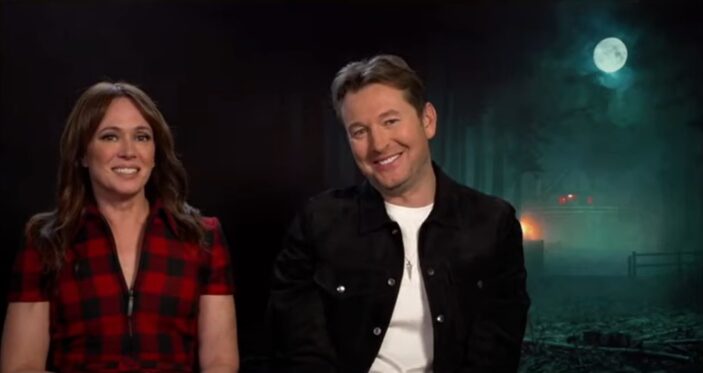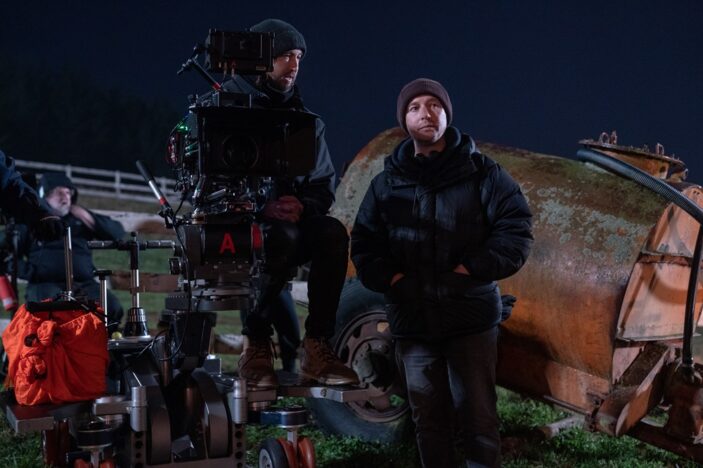
What if someone you loved became something else?
From Blumhouse and visionary writer-director Leigh Whannell, the creators of the chilling modern monster tale The Invisible Man, comes a terrifying new lupine nightmare: Wolf Man.
As Whannell’s unique take on the classic monster tale arrives in theatres across the globe (you can read our review here), Peter Gray spoke with both the writer/director and his writing partner Corbett Tuck to discuss exploring grief through their on-screen horror, the importance of sound in star Christopher Abbott’s transformation, and the evolution of tension from page to screen.
When it came to structuring the story, what did you find was the most important aspect that you both agreed on had to stay intact throughout the process?
Corbett Tuck: I think we liked the shifting of perspectives. We started with the idea that this was a marriage that was sort of falling apart, and so we wanted to created a thread of that, and into the physical transformation as well. You don’t hear each other anymore. You can’t see each other anymore. You can’t see things through the same eyes.
Leigh Whannell: That stayed from the very early stage.
Corbett Tuck: That was sort of the seed idea. And then it went from there.
It’s a film that explores so many themes. Whether it’s grief or relationships between parents or a husband and wife. I’m curious to know what makes horror such an interesting vehicle to explore those themes?
Leigh Whannell: I think it’s such a malleable genre. Because it’s expressing such extreme things that you can wrap around a lot of things. It’s a great metaphor, and it’s very cathartic. If there’s something that’s distressing you in the world, or in your own life, it’s really easy to exorcise it through a horror movie. You can take it to the very extreme. Suddenly, the metaphorically bloodthirsty banker who’s kicking people out of their homes becomes a literal vampire. You can nuclearise these monsters in our real life, and you can make them into real monsters. I think that’s what makes it such a malleable genre.
Could you elaborate on how you worked on the main concept of the transformation of the werewolf? Given that the transformation is such a major part of the mythology of the character, he stays rather human here. He never becomes a complete animal. Were there challenges in elaborating on a new concept?
Corbett Tuck: The transformation is just part of the mythology, and I think you nailed it. We wanted to focus on the human aspect of it, because we hadn’t seen it before. We wanted to avoid doing a retread of the same old story. The same old wolf story.
Leigh Whannell: I feel like what was interesting to us was the slow motion transformation. To me, the build up and the gradual descent is the most interesting part. It’s not the end result. That’s the journey there, and we wanted to slow that down.

On the transformation, one of the things I loved in the film was seeing the perspective from the other person, and seeing the colours and voices change. What trickery is taking place there? Is the dialogue in reverse? It was so brilliant, I want to know how it’s done.
Leigh Whannell: Oh, thank you. Thank you for saying that.
Corbett Tuck: We really just played Sergeant Pepper’s Lonely Heart backwards (laughs).
Leigh Whannell: That’s right. “Paul is dead.” (Laughs). No, we had great sound designers in Will Files and P.K. Hooker, who I’ve worked with on all my films. They are just brilliant. I love working with them. Even during the writing stage, I contacted them. We would go out to dinner and we’d talk about how we wanted the sound. We ended up not just reversing it, but getting the actors to record actual dialogue and then just layering it up. I was careful to say, “I don’t want this to sound far away.” I wanted it to sound up close. It’s not the distance that’s making it hard to understand. It’s actually that he can’t understand human language anymore. I feel like it was a good challenge. If I’m torturing sound designers, I’m doing the right thing. It was great. It was very fun.
The ever-ramping tension really got me. I’m curious to know what the evolution of a tense moment or a scare is from script to screen? What does it look like on the page? And then does it actually evolve when you get to the shooting process of, say, when you’re looking the scope at the beginning of the film and seeing the wolf man figure.
Leigh Whannell: Yeah, the barometer of tension…it’s difficult because everything goes in stages. They say you make the film three times. You make it when you write the film, then you shoot it, and then the film is made again in editing, in post. So with each times that you’re making the film, things change and swap around. I remember right even up to the last minute, Corbett would come and she would watch a work-in-progress (cut of the film), and she would have a few thoughts. You’re sort of swapping these pieces around.
It’s hard, because it’s not an exact science. There’s no recipe you can follow. You’re sort of improvising. I think if we end this scene two beats earlier, it’ll be more tense. In a way, you’re taking your best guess about what the most tense version is, and it’s gratifying to hear someone like you, because we’re really talking to the first people who have seen the film.
Wolf Man is now screening in Australian theatres.
